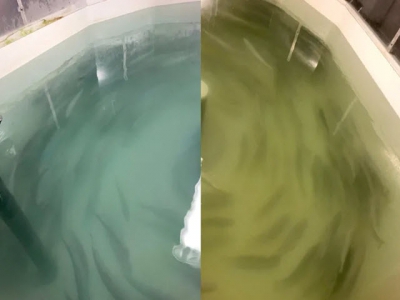Whats the optimum ozone level in RAS facilities?

Scientists have determined that salmon post-smolts tolerate similar levels of ozone in brackish water – which is increasingly used in RAS facilities – as they do in freshwater.
The colour of the water in the tank during the ozone trial shows the turbidity with (left) and without (right) ozone addition. Photo: Kevin Stiller, Nofima
Ozone is a strong oxidant, commonly used for improving water quality and disinfecting pathogens in freshwater fish farms. When ozone reacts with certain constituents of seawater, however, toxic byproducts can severely impact the health of fish populations. As brackish water is increasingly introduced in farming post-smolt salmon, thresholds for the safe use of ozone need to be established. Suppliers of recirculating aquaculture systems (RAS) are looking for safe, cost-efficient and reliable ways to maintain optimal water quality in brackish water RAS, and with this research they are now a step closer.
Scientists from Nofima and The Conservation Fund Freshwater Institute (TCFFI), both central in CtrlAQUA (Centre for research-based innovation), wanted to determine if ozone is safe for salmon in brackish water, and what the safe limits are for post-smolts.
The scientists carried out a trial determining the ozone limit in a flow-through system. Atlantic salmon at 100 grams were reared in brackish water of 12 ppt (parts per thousand) salinity for 12 days. They were exposed to ozone levels of 250 (control), 280 (low), 350 (medium), 425 (high) and 500 (very high) mV (millivolts). They identified ozone levels up to 350mV as potentially safe and 300 mV as safe for the health of post-smolts in flow-through brackish water.
In a follow-up study by Nofima that is not yet published, the identified threshold was confirmed for RAS. Carlo Lazado, fish health researcher in Nofima, will present the results at the digital conference “Smolt production in the future”, on 21 October.
Chris Good, scientist at TCFFI, reports that even lower ozone dosages are sufficient to improve water quality.
“This would depend on the quality of water being treated but in our experience in replicated freshwater RAS, a lower ozone level of 290 mV still resulted in significant improvements to water quality in general, including reduced biochemical oxygen demand and increased UV transmittance,” Good says.
“This new publication from CtrlAQUA highlights the effects of different ozone doses on the fish, therefore complementing our work here in the US on the water quality.”

Kevin Stiller was the lead author on a paper defining the threshold of ozone in brackish water. Here he is at the control room of Nofima’s RAS facility at Sunndalsøra. Photo: Terje Aamodt, Nofima.
Observed effects of too much ozone
There was high mortality after a few days in the two highest groups, and the highest group was terminated for this reason. For the group exposed to 350 mV, the scientists observed changes in the gills, but these were within the range of acceptable response. The mortality for this group was 1 percent and there was no mortality for the two lowest groups.
The scientists also tracked indicators of fish welfare, such as genes important for antioxidant defence and quality of skin and gills.
“What surprised us, was that ozone is much more aggressive on the gills compared to the skin. It means that gills are a good indicator tissue to check out the sensitivity to ozone,” says Lazado.
Need for accurate measurements
The recommendation of being below 350 mV for 100 gram post-smolt salmon in brackish water is consistent with ozone thresholds for other farmed fish species, and for salmon post-smolt in freshwater.
“When relying on this limit it requires that measurements of ozone in the production facility are accurate and reliable,” says Kevin Stiller, RAS researcher at Nofima.
In the research trial, the scientists needed to take the average from two probes to accurately measure the ozone level. That might also be a tip for the industry when measuring ozone level using today’s technology.
Industrial use
Stiller’s and Good’s experience is that both in Norway and North America you will typically see ozone application at less than 350mV in commercial RAS facilities.
Should ozone levels become toxic to fish, the morbidity and mortality is primarily the result of gill malfunction. The effects are observable to the naked eye, with increased respiratory rate and fish crowding near oxygen-rich tank inlet water.
View the scientific article “The Effects of Ozone on Atlantic Salmon Post-Smolt in Brackish Water—Establishing Welfare Indicators and Thresholds”
Có thể bạn quan tâm
 eDNA to tackle flesh-eating salmon parasite
eDNA to tackle flesh-eating salmon parasite A project that uses environmental DNA (eDNA) monitoring to alert salmon farmers to the presence of the parasite Kudoa thyrsites has been awarded funding.
 Fears over feminising antioxidants in fish feeds
Fears over feminising antioxidants in fish feeds One of the world’s top tilapia hatcheries has traced a radical upturn in the proportion of female tilapia in their normally all-male stock back to changes
 Mozambique warns of red spot disease among fish
Mozambique warns of red spot disease among fish Mozambique’s fishery authorities say they are on high alert for a potential outbreak of red spot disease after a recent outbreak in neighbouring Malawi.